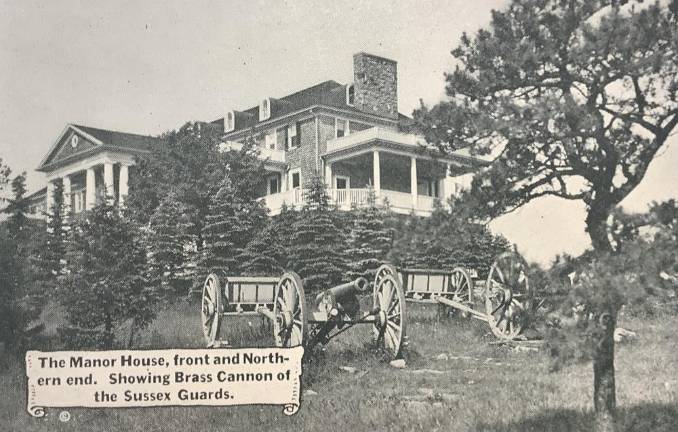
I am very pleased to have a guest historian this week: Ron Dupont of Vernon.
1923: High Point Park is Born
By Ron Dupont
By 1919 or so, Anthony Kuser had concluded that his family’s 12,000-acre High Point estate needed to go. His wife wouldn’t go there. And there was now an income tax, so even rich folk had to economize.
But what to do with it? His wife wanted it to become a park.
No stranger to the halls of power in Trenton, Kuser sent out feelers that he would gladly sell the property to the state for a great price. Maybe they wanted to turn it into a memorial to the fallen soldiers of the recent Great War or even a veteran’s cemetery? All such inquiries met dead ends.
So in 1922, Susie Kuser got her way: they announced that they would donate the property to the New Jersey for a public park. It was to be for public recreation and conservation of wildlife, particularly birds (Kuser was a bird lover). They did not mention veterans at the time. Perhaps they already had plans for later in that department.
High Point Park was managed by an appointed commission of five people, some of the most influential people in New Jersey, including Justice Joseph Gummere of the state Supreme Court. They appointed as superintendent John J. Stanton, a local newspaper publisher and Realtor who had been involved in High Point one way or another since the High Point Inn days.
For a decade, Stanton and the Park Commission worked to open the park with picnic grounds, swimming areas, scenic drives and camping spots. They turned the Kuser Mansion into a museum, visitor’s center and lodge.
Their work was guided by a plan prepared by the noted landscape architects the Olmsted Brothers, whose father designed Central Park.
The museum in Kuser Mansion was called one of the largest in the state and included Native American artifacts, stuffed animals, ship models, antiques and much more. On the front lawn were two Civil War nine-pounder cannons donated by the estate of Capt. Daniel Bailey of Glenwood.
Many of the early park facilities were modeled after those at another pioneer, Bear Mountain State Park on the Hudson. The two parks shared a similar vision, and both were frequently visited in the 1920s by state park planners from across the United States looking for ideas.
In 1928, Susie and Anthony Kuser added to their gift by proposing another: a 220-foot obelisk atop High Point, dedicated to New Jersey veterans of all wars. High Point Monument opened in 1930, but Anthony Kuser died before it was finished.
High Point Monument’s special role in veterans remembrance was recently added to the park’s name: High Point State Park & New Jersey Veterans’ Memorial.
After the monument was finished, the park built a cafeteria/restaurant, the Grey Rock Inn, now the park interpretive center. The nearby hillside featured downhill ski facilities.
The Great Depression temporarily brought an end to park development, but the Roosevelt Administration’s New Deal in 1933 created the Civilian Conservation Corps. For the next 11 years, two camps of young men worked to further improve the park, building Sawmill Road, Park Ridge Road, Sawmill Campground, Steenykill Lake, trails, picnic areas and the Appalachian Trail shelters. At the same time, the state built a restaurant (the Iris Inn, now the park visitor center on Route 23) and cabins on Steenykill Lake.
The next several decades saw few new improvements at High Point, while older, aging facilities were torn down. By the 1970s, the growth of the park system because of the Green Acres bonds meant High Point was not seeing the level of funding it once had.
Kuser Mansion began to deteriorate and was closed in 1979. The contents of the museum were transferred to other parks or lost, stolen or thrown out. The Bailey Civil War cannons likewise disappeared and were never seen again.
The state park system slated Kuser Mansion for demolition in the mid-1980s, leading to a decade-long fight with local historic preservationists. The Legislature appropriated $3 million to restore the building, but the money went unspent, and the appropriation was ultimately rescinded. Kuser Mansion was demolished in 1995.
One bright spot: the losing struggle to save Kuser Mansion resulted in creation of the 11,312-acre High Point Park Historic District, listed on the State and National Registers of Historic Places. This thumbnail sketch of the park’s history leaves out many interesting details that are covered in a book, “High Point of the Blue Mountains,” available at the park or from the Sussex County Historical Society.
It’s had its ups and downs, but after a century, High Point State Park continues to fulfill the Kusers’ vision of a park that protects wildlife and provides thousands of acres for public enjoyment, full of history, scenery, wildlife and nature. Be sure to visit it!
Bill Truran, the Sussex County historian, may be contacted at wrt1@columbia.edu